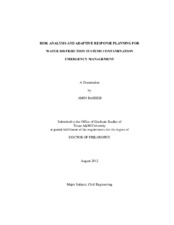| dc.contributor.advisor | Brumbelow, Kelly | |
| dc.creator | Rasekh, Amin | |
| dc.date.accessioned | 2012-10-19T15:30:07Z | |
| dc.date.accessioned | 2012-10-22T18:00:16Z | |
| dc.date.available | 2014-11-03T19:49:13Z | |
| dc.date.created | 2012-08 | |
| dc.date.issued | 2012-10-19 | |
| dc.date.submitted | August 2012 | |
| dc.identifier.uri | https://hdl.handle.net/1969.1/ETD-TAMU-2012-08-11533 | |
| dc.description.abstract | Drinking water distribution systems (WDSs) hold a particularly critical and strategic position in preserving public health and industrial growth. Despite the ubiquity of this infrastructure, its importance for public health, and increased risk of terrorism, several aspects of emergency management for WDSs remain at an undeveloped stage. A set of methods is developed to analyze the risk and consequences of WDS contamination events and develop emergency response support tools.
Monte Carlo and optimization schemes are developed to evaluate contamination risk of WDSs for generation of critical contamination scenarios. A multicriteria optimization approach is proposed that treats likelihood and consequences as independent risk measures to find an ensemble of uniformly-distributed critical scenarios. This approach provides insight into system risk and potential mitigation options not available under maximum risk or maximum consequences analyses.
Static multiobjective simulation-optimization schemes are developed for generation of optimal response mechanisms for contamination incidents with twoconflicting objectives of minimization of health consequences and impacts on non-consumptive water uses. Performance of contaminant flushing and containment are investigated. Pressure-driven hydraulic analysis is performed to simulate the complicated system hydraulics under pressure-deficit conditions.
Performance of a novel preventive response action ? injection of food-grade dye directly into drinking water ? for mitigation of health impacts as a contamination threat unfolds is explored. The emergency response is formulated as a multiobjective optimization problem for the minimization of risks to life with minimum false warning and cost. A multiobjective optimization scheme is used for the management of contamination events for diverse contaminant agents without interruption of firefighting.
A dynamic modeling scheme is developed that accounts for the time-varying behavior of the system during an emergency. Effects of actions taken by the managers and consumers as well as the changing perceived contaminant source attributes are included in the simulation model to provide a realistic picture of the dynamic environment. A dynamic optimization scheme is coupled with the simulation model to identify and update the optimal response recommendations during the emergency.
Machine learning approaches are employed for real-time characterization of contaminant sources and identification of effective response strategies for a timely and effective response to contamination incidents and threats. In contrast to traditional approaches that perform whole analysis after a contamination event occurs, proposed machine learning methods gain system knowledge in advance and use this extracted information to identify contamination attributes after an incident occurs. | en |
| dc.format.mimetype | application/pdf | |
| dc.language.iso | en_US | |
| dc.subject | Water distribution systems | en |
| dc.subject | Contamination | en |
| dc.subject | Emergency management | en |
| dc.subject | optimization | en |
| dc.subject | health impacts | en |
| dc.title | Risk Analysis and Adaptive Response Planning for Water Distribution Systems Contamination Emergency Management | en |
| dc.type | Thesis | en |
| thesis.degree.department | Civil Engineering | en |
| thesis.degree.discipline | Civil Engineering | en |
| thesis.degree.grantor | Texas A&M University | en |
| thesis.degree.name | Doctor of Philosophy | en |
| thesis.degree.level | Doctoral | en |
| dc.contributor.committeeMember | Zechman, Emily | |
| dc.contributor.committeeMember | Gardoni, Paolo | |
| dc.contributor.committeeMember | Lindell, Michael | |
| dc.type.genre | thesis | en |
| dc.type.material | text | en |
| local.embargo.terms | 2014-10-22 | |


